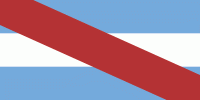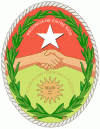Entre Ríos Province (Entre Ríos Province)
 |
 |
Its capital is Paraná (250,000 inhabitants), which lies on the Paraná River, opposite the city of Santa Fe.
Together with Córdoba and Santa Fe, since 1999, the province is part of the economic-political association known as the Center Region.
The first inhabitants of the area that is now Entre Ríos were the Charrúa and Chaná who each occupied separate parts of the region. Spaniards entered in 1520, when Rodríguez Serrano ventured up the Uruguay River searching for the Pacific Ocean.
The first permanent Spanish settlement was erected in the current La Paz Department at the end of the 16th century. As governor of Asunción first and then of Buenos Aires, Hernandarias conducted expeditions to Entre Ríos unexplored lands. Juan de Garay, after founding Santa Fe, explored this area, which he called la otra banda ("the other bank").
However, the region remained entirely indigenous and uninhabited by Europeans until a group of colonists from neighbouring Santa Fe Province settled on the Bajada del Paraná in the late seventeenth century, now the site of the provincial capital. At the same time towns appear, which we now know as Nogoyá, Victoria, Gualeguay, Gualeguaychú, Concepción del Uruguay and Concordia.
Tomás de Rocamora further explored the area in 1783 under the threat of a Portuguese invasion from Brazil, and gave official status to many of the above-mentioned towns. He was also the first to refer to the region as Entre Ríos. At this stage, European settlement was minimal, though during the May Revolution, the few colonists in the cities along the Paraná shore supported Manuel Belgrano and his army on his way to Paraguay.
On September 29, 1820, the leader (caudillo) Francisco Ramírez declared the territory an autonomous entity, the Republic of Entre Ríos. This lasted until his assassination on July 10 of the next year.
In 1853, in a meeting of all the provinces except Buenos Aires, Paraná was elected as the capital of the Argentine Confederation, and the Governor of Entre Ríos and leader (caudillo) Urquiza as its first president. The provincial capital was moved to Concepción del Uruguay. Later Urquiza, who had first won against Buenos Aires at the Battle of Cepeda in 1859, let his troops move back in the even Battle of Pavón in 1861, which allowed his rival Bartolomé Mitre from Buenos Aires to become president. At the time he was fulfilling his third term as governor of the province from 1860 to 1864 and after a voluntary interruption was reelected in 1886, but he was assassinated in 1870 after altogether 16 years of governing before finishing his mandate, which had probably been ordered by his supportor Ricardo López Jordán, not trusting him anymore.
Urquiza encouraged immigration through "colonization contracts", setting up many agricultural colonies with European (mainly Volga Germans, Russians (including Russian Jews and Poles), Italians, Swiss and French) settlers. According to data of the 1903 census, of the 425,373 inhabitants of the province, 153,067 were immigrants.
Map - Entre Ríos Province (Entre Ríos Province)
Map
Country - Argentina
 |
 |
| Flag of Argentina | |
The earliest recorded human presence in modern-day Argentina dates back to the Paleolithic period. The Inca Empire expanded to the northwest of the country in Pre-Columbian times. The country has its roots in Spanish colonization of the region during the 16th century. Argentina rose as the successor state of the Viceroyalty of the Río de la Plata, a Spanish overseas viceroyalty founded in 1776. The declaration and fight for independence (1810–1818) was followed by an extended civil war that lasted until 1861, culminating in the country's reorganization as a federation. The country thereafter enjoyed relative peace and stability, with several waves of European immigration, mainly Italians and Spaniards, radically reshaping its cultural and demographic outlook; over 60% of the population has full or partial Italian ancestry, and Argentine culture has significant connections to Italian culture.
Currency / Language
| ISO | Currency | Symbol | Significant figures |
|---|---|---|---|
| ARS | Argentine peso | $ | 2 |
| ISO | Language |
|---|---|
| EN | English language |
| FR | French language |
| DE | German language |
| GN | Guarani language |
| IT | Italian language |
| ES | Spanish language |
















